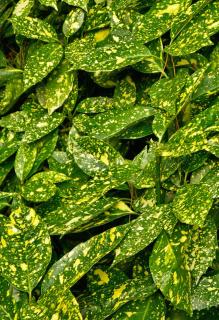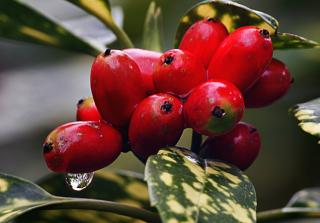

Spotted laurel is a very beautiful shrub, as nice in summer as it is in winter with its cute red berries.
Spotted laurel key facts
Name – Aucuba japonica
Family – Garryaceae
Type – shrub
Height – usually 3 to 10 feet (1 to 3 m)
Exposure – sun and shade
Soil: ordinary & cool – Foliage: evergreen – Flowering: end of fall → spring
Caring for this plant from planting to pruning will enable you to increase its growth and development.
Spotted laurel is a kind of shrub that doesn’t need a lot of sunlight to grow and is thus perfectly suited to growing in shaded areas of the garden.
Favor the fall season to plant it and keep a distance of 30 to 40 inches (80 to 100 cm) between plants if you plan to grow it as a hedge.
If planting in the spring, remember to water abundantly at the beginning to ensure proper settling in.
Lastly, to propagate your spotted laurel: preparing cuttings is your best option.
If part of a hedge, wait for the end of the blooming, in spring, to prune your spotted laurel.
 As a standalone, pruning isn’t really required, but you could still balance or reduce branches in spring.
As a standalone, pruning isn’t really required, but you could still balance or reduce branches in spring.
Avoid pruning it in fall at all costs, because you’d be interrupting fruit formation, thus depriving yourself of the beautiful cute berries that decorate the shrub all winter long.
Spotted laurel can bear pruning very well and can even be pruned back severely if need be. It will always grow back, even if cut directly at the stump.
Spotted laurel is a shrub that is both easy to care for and very tolerant in terms of maintenance.
It resists most diseases well. Additionally, spotted laurel is hardy to the cold and withstands excessive heat, too.
There are quite a few varieties and cultivars, all with interesting leaf patterns.
 This shrub is a staple item of our gardens. It bears its beautiful evergreen, mottled leaves all year long, and has the added advantage of bearing cute, little red round berries during the entire winter season.
This shrub is a staple item of our gardens. It bears its beautiful evergreen, mottled leaves all year long, and has the added advantage of bearing cute, little red round berries during the entire winter season.
Spotted laurel grows 6 to 10 feet (2 to 3 meters) tall in temperate climates, but some Aucuba japonica grow taller than 16 feet (5 m) in their native forest environment – Korea, China and Japan.
Its hardiness makes it a highly disease-resistant shrub. Also appealing to urban garden growers: spotted laurel copes with pollution well if you live in an urban setting.
The red berries only appear on female spotted laurel trees.
That’s why the question of a spotted laurel not bearing fruit often arises: it is a male specimen.
The botanical term to explain this is “dioecious”. It means male and female plants are separate and different. Both will bear flowers, which look different, but only female cultivars will produce berries.
Fruit formation only occurs if male and female specimens are planted close together.
Read also: